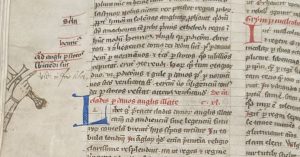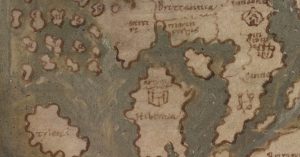
Dr Davina Quinlivan
The interdisciplinarian is best equipped to walk inside (and alongside) the lands of breathlessness, translating across border-lands wherever possible as she moves. This is because an inter-disciplinarian is identifiable by her movement, the willingness to depart from her discipline, to not be landlocked by her discipline’s vantage point. Instead of having shouted conversations across borderlands, she must travel the fields of knowledge making with an intradisciplinary effort
Alice Malpass, James Dodd, Gene Feder, Jane Macnaughton, Arthur Rose, Oriana Walker, Tina Williams, Havi Carel: 2019
Adopting the form of the Aboriginal songline, the team of researchers who led ‘The Life of Breath’ Wellcome Trust research project described their work as an interdisciplinary exploration of breath which required renewed attentiveness to their individual fields of study through the generative lens of the breathing body. Their investment in interdisciplinary contexts seems highly appropriate both to the original intentions of The Place of Breath in Cinema, and my body of work in the years that followed after the book’s initial publication in 2012.
Finding a rhythm
Imagine something we cannot see nor touch, but connects us to others in a multiplicity of ways. This was the project of my book The Place of Breath in Cinema, first published in 2012 with Edinburgh University Press. Here, I endeavoured to understand things we could not see in film, not just breath but air, residual spaces, dust, matter. These elemental fragments existed on screen and on the soundtracks of films, from the science fiction sounds of vacuum corridors to South Korean artist Kim Sooja’s transformation of La Fenice opera house into a ‘weaving needle’. My thinking involved ‘travelling the fields of knowledge’ through art history and literature, citing H.G Well’s The Invisible Man, Anthony McCall’s A Line Describing a Cone and The Pied Piper of Hamlin.
Locus
My research contributed to the field of phenomenological humanities and could not have been made possible without the pioneering work of Laura U. Marks (The Skin of the Film) and Vivian Sobchack (The Address of the Eye). Phenomenological Film Studies had already explored the potential of the embodied spectator but never, in any depth, the breathing gaze of that body. Given her critical dialogues with Martin Heidegger (The Forgetting of Air in Martin Heidegger) and Maurice Merleau-Pony (An Ethics of Sexual Difference), the French philosophy of Luce Irigaray seemed most revelatory and enriching. In her text The Age of the Breath (le temps du soufflé), Irigaray writes about how we have forgotten about air as the most fundamental mode of being; she establishes a new model of habitation with respect and care for this space. Irigaray’s thoughts seem startlingly literal in our pandemic era, but at the time of writing my book I was specifically drawn to the question of how cinema can do something different with that space, with the air between us as well as within our bodies.
A Breathing Visuality
As Derek Jarman’s single blue screen calls into being in his seminal film, Blue (1993), there is an ‘air’ conjured by the screen – a blurry, fuzzy, intersubjective space made up of dust and light particles. Contrastingly, in Douglas Gordon and Philippe Parreno’s Zidane: A 21st Portrait (2006), the digital representation of French footballer Zinedine Zidane, we see and hear Zidane’s misty breaths and groans on the pitch. This markedness the human voice and its movement through echoes and the air ‘outside’ is almost like ultrasound through a vibrant ecology of lived environments. After all, breathing engenders a duality between environ and self. Of course, there is also the wind, the desert storm, the mist and the fog.
Interdisciplinarity
I have since written about rhythms and silences of all kinds, especially in the theorisation of trauma or healing in literature as well as film. In recent years, I have written about ecologies of air and the evocation of such spaces in literature and art; the post-colonial representation of invisible or silenced bodies and water as well as fire. This also extends to my creative writing and the rural soundscapes of wind and bells chiming in my memoir, Shalimar: A Story of Place and Migration, which I have also recently recorded as an audio-book.
While The Place of Breath in Cinema is a phenomenological enquiry into cinema and haptic discourse, positing a new model of haptic aurality and embodied film experience, it also opened up questions of healing and the ethics of film experience which were at the centre of my second monograph and my engagement with the psychoanalytic thought of Melanie Klein in Filming the Body in Crisis: Trauma, Healing and Hopefulness (Palgrave: 2015).
After many years writing on the subject of air and breath, I remain fascinated by new configurations of this field in literature, the medical humanities and the environmental humanities and new materialist approaches to sound. I have also had the great pleasure of examining PhDs on a range of topics relating to breath in visual culture and the humanities – something I could not have imagined when I began to write my MA dissertation on the gothic literature of Patrick McGrath and David Cronenberg’s adaptation of his story, Spider (2002).
Dedicated to Prof Sarah Cooper, King’s College London.
About the book

Order your copy
The Place of Breath in Cinema
by Davina Quinlivan
This study considers the locus of the breathing body in the film experience and its implications for the study of embodiment in film and sensuous spectatorship.
About the author

Davina Quinlivan is a Lecturer in the Department of English and Creative Writing at The University of Exeter.





